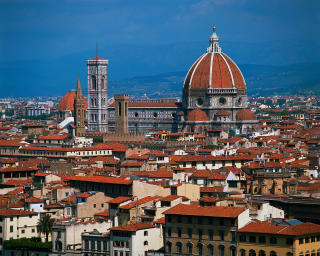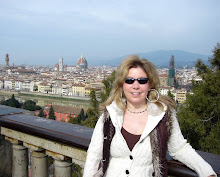
The students took their third Italian Life and Culture class field trip today to the Accademia, home of Michelangelo's David. How fortunate that my parents were in Florence and were able to go along with the group. The Accademia is Florence's Academy of Fine Arts, founded in 1563. This was the first school in Europe that taught drawing, painting, and sculpture. Any fine arts academy naturally has a fine display of art, something that students can use as material to study and copy, and the Accademia's collection might well be the finest in the world.
 Most people think of the Accademia solely in terms of David, but there is so much more here. In fact, many of Michelangelo's most important works, in addition to David, are housed here, including a statue of St. Matthew and the Quattro Prigioni (the Four Prisoners), which was originally intended to decorate the tomb of Pope Julius II. Also on display are works by Fra Bartolomeo, Filippino Lippi, Boticelli, and many others. What I found most beautiful was the Adimari chest (a hope chest) lavishly painted during the Renaissance by Giovanni di ser Giovanni, which depicts a wedding procession of everyday Florentine families, with the Baptistery in the background. The background also shows typical Renaissance homes that owners had cleverly expanded by extending the top floors outward (since they couldn't do this with the ground floor) and supporting the additions with thick wooden beams. (My parents and I managed to later locate some of these structures, still standing a block away from the Duomo.)
Most people think of the Accademia solely in terms of David, but there is so much more here. In fact, many of Michelangelo's most important works, in addition to David, are housed here, including a statue of St. Matthew and the Quattro Prigioni (the Four Prisoners), which was originally intended to decorate the tomb of Pope Julius II. Also on display are works by Fra Bartolomeo, Filippino Lippi, Boticelli, and many others. What I found most beautiful was the Adimari chest (a hope chest) lavishly painted during the Renaissance by Giovanni di ser Giovanni, which depicts a wedding procession of everyday Florentine families, with the Baptistery in the background. The background also shows typical Renaissance homes that owners had cleverly expanded by extending the top floors outward (since they couldn't do this with the ground floor) and supporting the additions with thick wooden beams. (My parents and I managed to later locate some of these structures, still standing a block away from the Duomo.) But it's really David that people come to the Accademia to see, and he doesn't disappoint. David, who was completed in 1504, originally stood in the Piazza della Signoria; he was moved to the Accademia in 1873, a short move that took several grueling days. David, whom Michelangelo carved out of one solid piece of marble, is a colossal figure standing 17 feet tall. It depicts the young version of the biblical David, who killed the giant Goliath. Many believe that Michelangelo carved David at the moment he first spotted Goliath, before the kill, making it unique among Davids done by other artists. A special area within the Accademia was created specially for David, and he stands proudly there, awaiting his visitors.
You might notice that I'm writing about David as if he is living; that's because this statue is so magnificent that it seems alive. In fact, our tour guide repeatedly referred to "David" during our tour as if he were a living, breathing man. It's difficult to think otherwise.
But David hasn't always had an easy life. In 1527 his left arm was broken off when rioters tossed a chair out of the window of the Palazzo Vecchio. And in 1991 a vandal attacked David with a hammer, damaging the toes on his left foot. Nevertheless, he stands in the Accademia in all his perfection today, and I am so glad that I had the opportunity to see this magnificent creation during my lifetime.
 David makes one feel like celebrating, and that's exactly what we did next. You see, Toni's daughter Molly turned 7 the previous Monday, March 5, and her dad Coley turned 75 the same day. So we all decided to have dinner at her villa to celebrate. Yes, her villa. Although Toni won't really talk about it, she is living in a grand Tuscan villa on the other side of the Arno, complete with acres of land that has vineyards, a hedge maze, and a perfect view of Florence from high atop a hill, reached by hiking up an ancient Roman road.
David makes one feel like celebrating, and that's exactly what we did next. You see, Toni's daughter Molly turned 7 the previous Monday, March 5, and her dad Coley turned 75 the same day. So we all decided to have dinner at her villa to celebrate. Yes, her villa. Although Toni won't really talk about it, she is living in a grand Tuscan villa on the other side of the Arno, complete with acres of land that has vineyards, a hedge maze, and a perfect view of Florence from high atop a hill, reached by hiking up an ancient Roman road.When my parents and I arrived, Molly gave us a thorough tour of the entire villa, which has numerous bedrooms and five, yes five, bathrooms. Every window overlooks the beautiful grounds, some of the first green I've seen since arriving in Florence. This villa is so special that two books have been written about it, and Toni and her family are fortunate enough to live here for four months. How they must love it!
 Molly certainly loves it as it was clear that she was ecstatic to show us around. And because we were celebrating her birthday, she felt like a queen, complete with her stuffed animal Buddy as a crown.
Molly certainly loves it as it was clear that she was ecstatic to show us around. And because we were celebrating her birthday, she felt like a queen, complete with her stuffed animal Buddy as a crown.




 Over a dinner of pasta and salad, we toasted Coley and Molly on their special day, all of us enjoying the food and the company.
Over a dinner of pasta and salad, we toasted Coley and Molly on their special day, all of us enjoying the food and the company.


 And after dinner it was time for birthday cake, three of them to be exact, including the famous "funfetti," evidently the traditional birthday cake in the Fannin household.
And after dinner it was time for birthday cake, three of them to be exact, including the famous "funfetti," evidently the traditional birthday cake in the Fannin household. 

There were presents for Molly, and gifts for all of the girls to celebrate La Festa della Donna (Woman's Day), which was to be celebrated in Italy the following day (more on that later), and everyone had a grand time. My parents felt right at home and thoroughly enjoyed meeting all of my wonderful colleagues and their families. (It's just too bad that Molly didn't have any fun!)
(It's just too bad that Molly didn't have any fun!)
 (It's just too bad that Molly didn't have any fun!)
(It's just too bad that Molly didn't have any fun!)




No comments:
Post a Comment